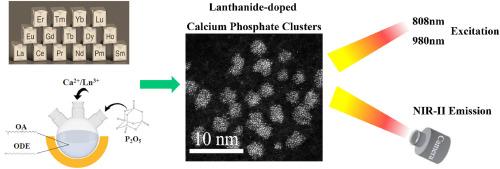用于氟磷灰石纳米点形成和NIR-II生物成像的钕嵌入超小型仿生磷酸钙簇
IF 8.2
2区 材料科学
Q1 MATERIALS SCIENCE, MULTIDISCIPLINARY
引用次数: 0
摘要
同时具有高亮度和良好生物相容性的荧光团的近红外-II 储库有限,阻碍了近红外-II 的临床转化。在本文中,我们将钕(Nd3+)作为核寄存到仿生物磷酸钙团簇(CPCs)中,使其结晶成氟磷灰石(FAP)纳米点,并报告了一种新型的镧系近红外-II 纳米探针。结果表明,掺杂的 Nd3+ 与 CPCs 中的磷酸盐形成了配位更强、更紧密的纳米团簇,其超小型尺寸为 2.61 ± 0.24 nm。此外,CPCs 中 Nd 的上转换过程几乎被抑制,并表现出强烈的下转换 NIR-II 光致发光特性。CPCs 中激发态(Nd: 4F3/2)的寿命为微秒级,并且在 80 K 至 320 K 温度范围内与温度无关。Nd-FAP 纳米晶体呈纳米点状,长宽比为 1.53,平均长度为 7.70 ± 1.11 nm,直径为 5.02 ± 0.64 nm,计算得出其绝对光量子产率为 0.526 ± 0.053 %。经过 PEG 化处理以增强亲水性后,NIR-II 纳米探针可对小鼠器官和腘窝淋巴结进行实时、无创的体内成像。这一新的宿主系统可开发为一个多功能平台,用于设计和制备其他新的近红外-II探针(掺镨、掺钬和掺铥)、核磁共振成像剂(掺钆),甚至是多重/多模态生物标记物,它们在体外或体内生物成像和生物传感应用中可能具有巨大潜力。本文章由计算机程序翻译,如有差异,请以英文原文为准。

Neodymium-embedded ultrasmall biomimetic calcium phosphate clusters for fluorapatite nanodot formation and NIR-II bioimaging
The limited concurrent NIR-II reservoir of fluorophores that simultaneously possess high brightness and excellent biocompatibility hampers the clinical translation of NIR-II. Herein, we host neodymium (Nd3+) into biomimetic calcium phosphate clusters (CPCs) as nuclei to crystallize into fluorapatite (FAP) nanodots, and report a novel type of lanthanide-based NIR-II nanoprobes. Results show that the doped Nd3+ forms more strongly coordinated and compact nanoclusters with phosphate in CPCs with an ultrasmall size of 2.61 ± 0.24 nm. Moreover, the up-conversion process of Nd in CPCs is nearly inhibited and exhibits intense and characteristics of down-conversion NIR-II photoluminescence. The lifetime of the excited states (Nd: 4F3/2) in CPCs locate at the microsecond level and is temperature-independent from 80 K to 320 K. To raise the absolute photoluminescence quantum yield (PLQY) of Nd-CPCs, the clusters are further crystallized into Nd-FAP nanocrystals. The Nd-FAP nanocrystals are of nanodots shape and show aspect ratio of 1.53 with an average length of 7.70 ± 1.11 nm, and diameter of 5.02 ± 0.64 nm, and the PLQY is calculated to be 0.526 ± 0.053 %. Following PEGylation for enhanced hydrophilicity, the NIR-II nanoprobe enables real-time, non-invasive in vivo imaging of mouse organs and the popliteal lymph node. This new host system may be developed as a versatile platform to design and prepare other new NIR-II probes (praseodymium, holmium, and thulium-doped), MRI agents (gadolinium-doped) and even multiplexed/multimodal biomarkers, which may hold great potential in in vitro or in vivo bioimaging and biosensing applications.
求助全文
通过发布文献求助,成功后即可免费获取论文全文。
去求助
来源期刊

Materials Today Nano
Multiple-
CiteScore
11.30
自引率
3.90%
发文量
130
审稿时长
31 days
期刊介绍:
Materials Today Nano is a multidisciplinary journal dedicated to nanoscience and nanotechnology. The journal aims to showcase the latest advances in nanoscience and provide a platform for discussing new concepts and applications. With rigorous peer review, rapid decisions, and high visibility, Materials Today Nano offers authors the opportunity to publish comprehensive articles, short communications, and reviews on a wide range of topics in nanoscience. The editors welcome comprehensive articles, short communications and reviews on topics including but not limited to:
Nanoscale synthesis and assembly
Nanoscale characterization
Nanoscale fabrication
Nanoelectronics and molecular electronics
Nanomedicine
Nanomechanics
Nanosensors
Nanophotonics
Nanocomposites
 求助内容:
求助内容: 应助结果提醒方式:
应助结果提醒方式:


